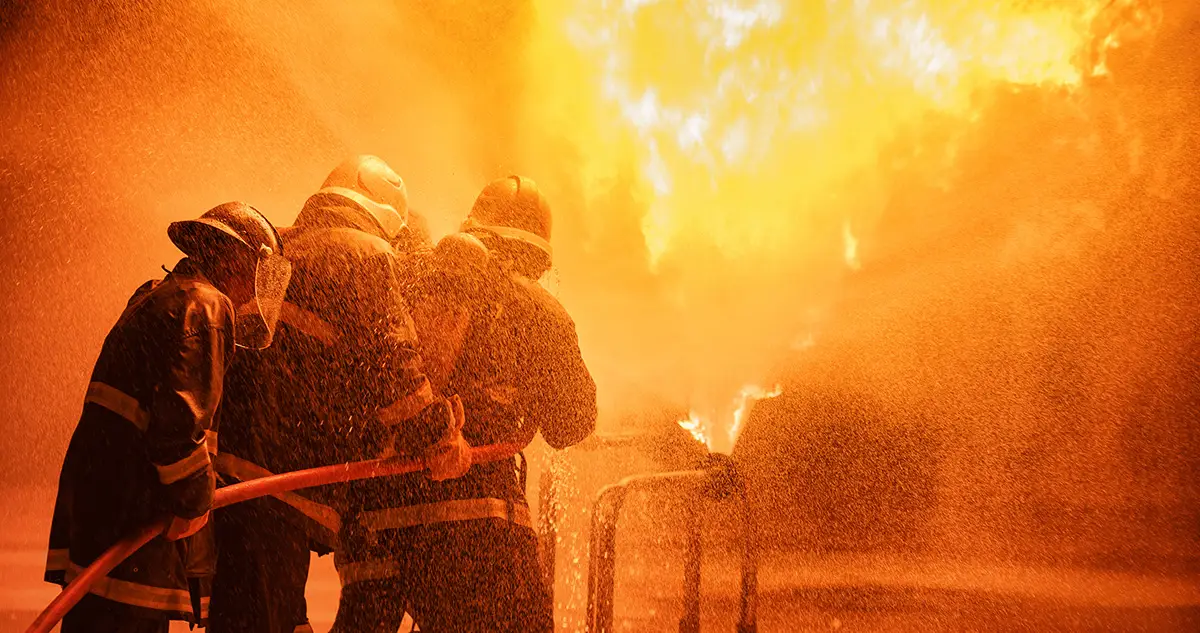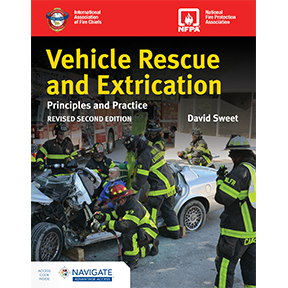Firefighter Training Ideas and Topics for Instructors

Widely considered one of the most challenging and high-stakes professions in the world, firefighters are tasked with thinking on their feet and working as a team to save lives.
Good firefighter training is essential to ensure that every fire department member is prepared to tackle emergency incidents in real-time. Training a roomful of firefighters means more than just preparing students to knock down fires. You will need to become an expert in a wide variety of skills including:
- The proper use of personal protective equipment (PPE)
- The appropriate use of ropes—and knots in some cases
- Understanding how to assess a hazmat scene
- Recognizing how and when to communicate with partners and leaders before, during, and after an incident.
Read on for a closer look at the value of fire service education and the firefighter training ideas and resources that instructors can leverage.
Fundamental Firefighter Training Topics for Educators To Cover
According to the National Fire Protection Association (NFPA), there were an estimated 1,018,000 firefighters in the U.S. in 2023—with 37 percent being characterized as career firefighters and 63 percent labeled as volunteers. Volunteers are expected to operate at the same skill and experience level as careered professionals. This underscores the importance of proper training across firefighting positions to ensure every stakeholder is capable of responding to emergency calls efficiently and successfully.
Fire service inherently demands a commitment to consistent training to guarantee firefighters and other fire-related professionals are adequately armed with the knowledge, skills, and abilities required to perform their job. This includes preparing for emerging risks as well, such as active shooter incidents, the increased prevalence of natural disasters, and the accelerated growth of technologies.
With the importance of continuous fire service learning in mind, here are essential training topics and ideas for instructors to integrate into their curriculum moving forward:
1. Fire Behavior
Helping students understand the science of fire and how it behaves in different environments—in addition to powerful strategies for extinguishing fires, controlling fire spread, and maintaining firefighter safety—is vital to the training process.
This includes covering topics such as fire suppression systems, equipment, and techniques. While most recognize common equipment for the job such as extinguishers, foam, and hydrants, the industry is continuing to learn more about these approaches.
For instance, those in fire service are often well-versed in the clothes, pumps, and pressures involved in fire suppression and water application, but there is a lack of information surrounding how these techniques impact the environment. Instructors should educate firefighters on the potential water wastage and contamination of natural ecosystems that are tied to such suppression systems.
In modern firefighter education, it is also essential to teach based on task rather than rank. At the scene of a fire, for example, the arriving firefighter could be in a command role, without holding a specific rank—like captain, lieutenant, or chief officer. But, regardless of their position, every firefighter on the fireground should have the same knowledge and skills under their belt to respond appropriately.
Fundamentals of Firefighter Skills, Fifth Edition
The all-new Fifth Edition of Fundamentals of Firefighter Skills is the must-have training resource for Firefighter I and Firefighter II.
Learn More2. Fire Dynamics
Understanding fire behavior is only one portion of effective firefighter education. In addition to training in the classroom, instructors should also introduce valuable learning opportunities in real life—providing a more comprehensive understanding of how fires grow, spread, and interact with their environment. This might include props, candle labs, pressure labs, or fire labs.
UL’s FSRI offers fire dynamics boot camps to support on-the-ground learning, so classroom information can become supplementary to real-life skills. This ultimately enhances firefighter safety, situational awareness, and fireground decision-making.
3. Personal protective equipment (PPE)
Because PPE is a critical component of a firefighter’s gear, providing professionals with valuable information about protective equipment against hazards is essential. This includes education on the potential concerns related to certain types of PPE materials that may contain per- and poly-fluoroalkyl substances (PFAs). This class of chemicals has been linked to adverse health effects, making it beneficial to explore alternative PPE options that are free of PFAs—or with lower levels.
Instructors should also focus on building awareness among firefighters regarding the purpose of their gear and the various hazards it protects them against. For example, do learners know how long their PPE will keep them safe from second-degree burns? Such knowledge can empower fire service professionals to not only appreciate the value of their gear but also understand its precautions and limitations.
4. Search and Rescue Operations
Firefighters need to be trained to conduct search and rescue missions, which are necessary in a variety of situations from residential fires to trench rescue operations.
This requires a high level of skill, communication, and coordination between team members, but it is important to keep in mind that UL's Fire Safety Research Institute (FSRI) is continuing to come out with critical research as the industry evolves. This means the best practices for safety in emergency incidents may change—and it will be vital to stay up-to-date as a result.
For instance, while firefighters have been taught for years to go as far back into a building as possible and subsequently make their way back when conducting search and rescue missions, this is no longer the case. With supplemental research, it stands to reason that this can be dangerous for survivors that do not have the same protective equipment as the firefighters, and it is not always necessary to use the same route to exit the building.
Additionally, rope and technical rescue techniques are increasingly being incorporated into lesson planning. Learn more about how rope and technical rescue is changing.
This is just one example of why educators will need to continuously update training materials to reflect the most current research moving forward.
5. Hazardous Materials Awareness, Response, and Operations
Firefighters are often called upon to handle hazardous materials situations, which can quickly pose a risk to responders and the public alike. Fire training curriculum is increasingly prioritizing hazardous materials education, including what fire professionals may encounter, how to safely respond, and how these individuals can protect themselves and others from harm in the process. Hazards and hazmat incident teaching can include:
- The proper use of chemical protective equipment (CPE)
- Decontamination techniques
6. Vehicle and Machinery Extrication
Car and industrial machine accidents require firefighters to adopt critical skills that help them adequately respond to these emergencies. For vehicle and heavy machinery safety and preparation, educators can consider the following topics:
- Understanding the anatomy of vehicles and machinery (e.g., airbags, seat belts, hydraulic, and systems)
- Specific tools and techniques (e.g., the jaws of life, cutters, and spreaders—to name a few)
- Incident scene safety and patient care
- Changes in how EMS workers use lights and sirens
- Emerging vehicle battery technologies
Vehicle Rescue and Extrication: Principles and Practice, Revised Second Edition
Vehicle Rescue and Extrication: Principles and Practice, Revised Second Edition helps technical rescue professionals remain safe and capable by delivering the most current practical skills and information available on today's increasingly technical vehicles.
Request Your Digital Review Copy
How to Teach Ever-Evolving NFPA Standards
It is important that instructors stay up to date on evolving NFPA standards. The NFPA 1410 training (i.e., the National Fire Protection Association’s standard for live fire training) is a particularly critical aspect for instructors to consider. This involves education on how to work as a team, extinguish a fire, simulate real-world conditions, and prepare firefighters and other crew for the physical and mental challenges they can anticipate facing on the job. However, NFPA standards are updated regularly, requiring fire instructors to highlight any changes made. This involves running traditional standards against newly instated ones, so they can keep pace and develop strategies to teach any modifications effectively.
Fire educators can stay up-to-date with varying standards and teach NFPA training successfully by:
- Incorporating a variety of instructional methods to meet diverse learner needs (e.g., hands-on practice, emergency simulations, and online learning)
- Utilizing case studies and real-world scenarios to help fire service students apply standards to potential situations in the field
- Leveraging interactive training tools and resources—for instance, videos and mobile applications—to boost the learning experience
- Providing ongoing education and recertification opportunities to empower firefighters to stay refreshed on NFPA best practices
- Introducing opportunities to promote physical fitness, preparing firefighters to do their job each and every day
- Overseeing evolutions in the discussion around mental health (i.e., undoing the enduring stigma surrounding this discourse)
The Key Benefits of Comprehensive Firefighter Training
As fire training officers introduce up-to-date, premium education resources, fire departments can elevate learning results and engagement—leading to a range of benefits such as:
- Increased safety: More exhaustive training helps firefighters and fire service professionals better recognize and respond to hazards and emergency incidents, effectively reducing the risk of injury.
- Improved preparedness: Adequate fire education prepares firefighters with the foundational skills they need to respond adequately to a range of emergencies—from fires and hazardous materials incidents to water rescues and vehicle extrication.
- Enhanced critical thinking: Updated resources that offer realistic scenarios for professionals to absorb in the training process can help them develop critical thinking skills that strengthen decision-making in real-world situations.
- Upgraded public service: Firefighter education is ultimately a core aspect of ensuring public safety. Proper practice is the foundation for equipping firefighters to handle emergencies with confidence and building trust within the community.
- More efficient use of resources: A fire department’s training resources are vital assets for organizational success. More engaging, extensive, and up-to-date fire preparation courses and programs encourage the optimized use of time and equipment during fires or other emergency incidents.
Fire service instructors are also introducing immersive VR training to achieve unique benefits. This can enhance classroom learning and replace traditional live fire training with a safe controlled environment for firefighters to practice critical skills and experience realistic scenarios. Additionally, immersive training is easy to repeat, customize, and keep consistent, helping to ensure all fire service professionals are well-prepared to face the challenges of real-life firefighting situations.
Resources to Support Improved Training
The U.S. The Bureau of Labor Statistics projects the employment of firefighters to grow four percent from 2023 to 2033, averaging about 27,500 openings for firefighters each year over the decade. This is driving the need for enhanced training strategies and resources for fire service instructors, to help them efficiently bring newcomers up to speed—not to mention upskill seasoned professionals as firefighter training ideas and standards continue to evolve.
Learn more about firefighter training resources from Public Safety Group.
Related Content:
- Leadership Must Embrace Major Changes in the Fire Service for the Good of Its Future
- This Is Why You Should Make ‘Community Risk Reduction’ A Key Part of Your Fire Service Curriculum
- How the Flipped Classroom Approach Could be a Solution to Firefighter Staffing Challenges
- Highway Scene Safety 101: Training and Best Practices for EMS & Firefighters
- When Heat Waves Scorch the U.S., Teaching Firefighters and EMS Professionals How to Manage Heat-Related Injuries Takes Center Stage
- How Can EMS and Fire Educators Prevent Cheating in the Classroom?
